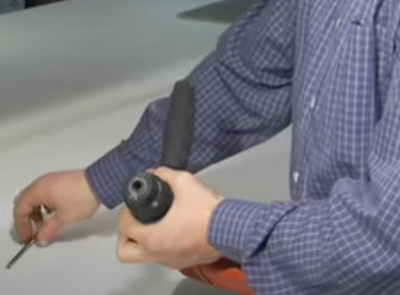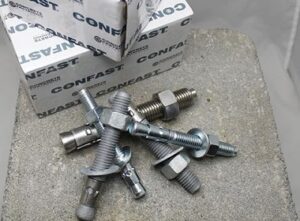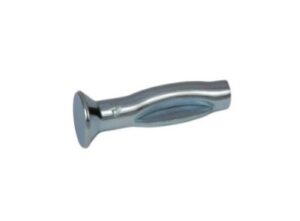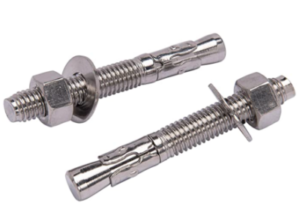We have taken this opportunity to compile a list of the typical equipment needed to install concrete fasteners. Each item listed goes into depth on the whys and the hows to using that particular tool.
Hammer Drills
The term hammer drill refers to a drill that has a movement that goes up and down in a chuck and has a rotation motion – the bit turns in the chuck. There are many manufacturers of hammer drills.
There are two basic types of hammer drills. One type is the hammer drill that has a standard Jacobs style chuck i.e. a chuck where the chuck key is used to tighten the chuck against the bit. The second type is the keyless chuck that does not require a chuck key. These are commonly referred to as SDS, SDS+, SDS Max, and Spline. Each one of these keyless chuck bits fit into different types of hammer drills. The SDS and SDS+ fit into the same chuck and the SDS Max fits into larger drills. The spline carbide bit is used with another style of the hammer drill.
Proper bits are essential
It is very important that the proper bit is matched up with the proper drill because the bits are not interchangeable and will not work in a drill that is not designed for the specific style of bit. All safety precautions designated by the drill manufacturer should be read and carefully followed. The instruction manual or owner’s manual is very important to use during the entire installation process. Safety goggles and earplugs should also be worn when using hammer drills.
Newer hammer drills have a clutch built into them and if the bit and if the bit should get bound in the hole, then the motor will disengage. Older models may not have this feature so the operator should be aware of the lack of this important safety precaution. When using hammer drills without a clutch it is important that the operator understands the risks involved. If the bit should get bound up in the hole, there could be enough power to break the operator’s wrist or throw the operator from a ladder.
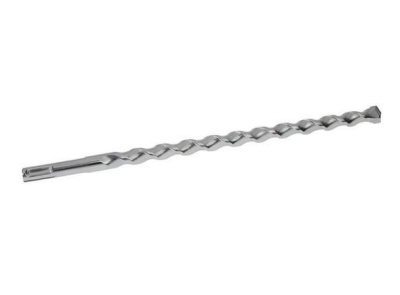
Carbide Tipped Drill Bits
Carbide tipped drill bits must be used when drilling holes in concrete. Holes drilled in concrete that will be used for concrete fasteners must meet ANSI standards since hole tolerance is critical. All SDS, SDS+, SDS Max and Spline bits meet these standards and have assured critical hole tolerances that are required.
The straight shank bits that are used in Jacob’s style chucks may not meet ANSI standards and may not be suitable for drilling holes for concrete anchors. Most high-quality straight shank bits meet standards and the packaging will state if the bits meet ANSI standards. The carbide at the end of the bit crushes the concrete from the hammer motion of the drill and the flutes remove the dust from the hole. Flute design is critical for efficient dust removal. The drill will only be able to drill as fast as the dust is completely removed from the hole.
Hammer
The wedge anchor, sleeve anchor, drop-in anchor, concrete strike anchor and hammer drive anchor require the use of a hammer to either set the anchor or pound the concrete anchor into the hole in the base material. It is important to use a lighter hammer on smaller anchors and a heavier hammer for large diameter anchors. It is important when using sleeve anchors and wedge anchors that the nut is placed on the threaded portion of the anchor to protect the threads from possible damage while striking the anchor with a hammer. Make sure the anchor is struck perpendicular because smaller diameter anchors (such as 1/4″) may bend if not struck properly. It is very important to wear safety goggles when using a hammer to install concrete fasteners.
Wrench
The type of wrench used will be an individual choice based on the particular application the concrete anchors are being used for. All the nuts used with concrete fasteners are standard and require no special tools. For example, a 3/8″ wedge anchor requires a 3/8″ nut. The sleeve anchor is the only anchor where the nut does not match in this way. Since the sleeve anchor has a sleeve that goes over the stud, the stud is smaller than the designated diameter. When working with sleeve anchors, the nut will be one size smaller than the diameter of the anchor. For example, a 3/8″ sleeve anchor requires a 5/16″ nut. The wedge anchor has torque values associated with each diameter and a torque wrench may be used to ensure that the wedge anchors are torqued properly.
Vacuum
After the hole is drilled into the base material, the hole needs to be cleaned out properly before installing the concrete fasteners. Base material dust can decrease the holding values allowing the anchor to slip. A large amount of dust may not allow the anchor to be fully embedded into the base material properly. A vacuum can be used in conjunction with a wire brush. This will ensure that all dust is removed from the hole. When using a vacuum, first suck out all of the dust that was created during drilling. Then use a wire brush in the hole then vacuum the rest of the dust.
Compressed Air
Compressed air using an air compressor or a blow-out-bulb may be used to remove the dust from the hole in the base material. The air should also be used in conjunction with a wire brush to ensure complete dust removal. It is important to blow out the hole, then use a wire brush and finally blow out the hole again.
Wire Brush
The wire brush should be sturdy enough to be able to scrape the walls of the hole in the base material. You should move it up and down the entire depth of the hole. Using a vacuum or compressed air along with a wire brush will help ensure complete dust removal.
All of these accessories and tools will help ensure that the drilling for and installation of concrete anchors for your specific application goes smoothly. Always remember to reference manufacturer’s instructions and safety precautions as well.
About Concrete Fastening Systems
Concrete Fastening Systems, LLC has sold concrete fasteners for over 30 years from a fully stocked warehouse in Cleveland, Ohio. Free, same-day shipping in every length and diameter is available by ordering at www.confast.com. You should then expect product delivery within 1-3 days.

